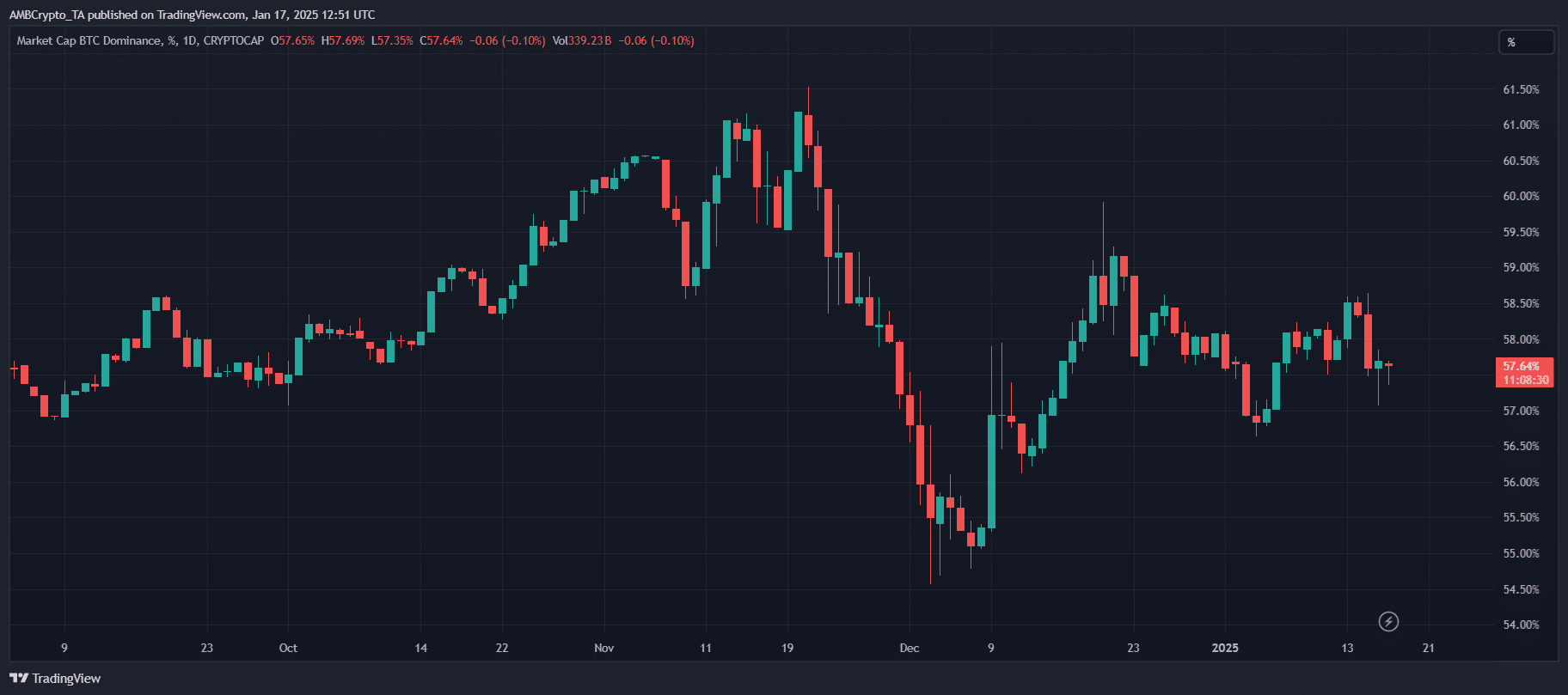-
Bitcoin is poised to maintain its dominance in the cryptocurrency market through 2025, bolstered by strong institutional interest and utility advancements.
-
Factors such as the rapid adoption of Bitcoin ETFs and significant investments from corporations underscore its pivotal market position.
-
According to a JPMorgan analysis, “Bitcoin continues to outpace Ethereum and other altcoins,” signaling its enduring strength in a competitive landscape.
Bitcoin’s market dominance is set to remain strong through 2025, fueled by institutional investments and utilitarian advancements in its network.
Bitcoin’s market dominance
Bitcoin’s market dominance currently hovers around 55%, showcasing robust stability despite the marketplace’s inherent volatility. Currently fluctuating between 57% and 58%, Bitcoin’s position as the preferred store of value serves as a significant attraction amidst uncertain economic conditions and ongoing regulatory scrutiny faced by many altcoins.

Source: TradingView
Despite Ethereum’s stagnant performance and the inability of other altcoins to capture market share, Bitcoin benefits significantly from phenomenal institutional interest, indicating its sustained reputation as the leading digital asset. Periodic market corrections are evident on the charts, which are typical of natural market cycles.
Ultimately, Bitcoin’s trajectory reflects its persistent appeal and emphasizes its critical role in shaping the future of the cryptocurrency market in 2025.
What’s behind it?
According to JPMorgan analysts, eight crucial drivers are expected to bolster Bitcoin’s market dominance in the coming years. Prominently, Bitcoin is seen as the digital counterpart to gold, fostering substantial inflows into Bitcoin ETFs, which starkly contrasts with muted interest in altcoin ETFs, including Ether, that have gathered only $2.4 billion in inflows to date. Furthermore, MicroStrategy’s aggressive $42 billion Bitcoin acquisition strategy remains halfway through, anticipated to contribute positively to Bitcoin’s market momentum.
The likelihood of U.S. states or central banks building crypto reserves almost exclusively with Bitcoin further solidifies its perceived value as a reserve asset. Additionally, innovative changes in Bitcoin’s Layer 2 networks have introduced smart contract capabilities, positioning Bitcoin as a viable competitor to Ethereum in decentralized finance (DeFi) applications.
Moreover, as institutional blockchain applications gradually migrate towards private networks, the reliance on public blockchains like Ethereum is diminishing. Emerging infrastructures like Base emphasize development over mere token issuance, indicating a decreasing focus on existing altcoins. Lastly, the regulatory uncertainties in the United States reinforce Bitcoin’s status, allowing it to thrive in an environment that remains skeptical of altcoin viability.
Shifting market dynamics
The ongoing evolution in the market landscape exhibits Bitcoin’s challenge to Ethereum’s dominance, particularly when it comes to utility. Significant Layer 2 enhancements empower Bitcoin, extending its functionality beyond mere storage of value and fortifying its market leadership.
Simultaneously, there is a marked shift amongst institutional adopters toward private blockchain networks, prized for their tailored solutions and privacy — elements that lessen the relevance of public blockchains like Ethereum for applications such as digital bond trading. Notably, dedicated infrastructure projects such as Coinbase’s Base suggest a strategic pivot from token-centric models to value-centric approaches focused on corporate sustainability and growth.
In light of prevailing regulatory uncertainties in the U.S., the broader adoption of altcoins is stymied, allowing Bitcoin to rally amid ongoing market consolidation. With continued institutional appeal and adaptability, Bitcoin’s stronghold as a leading cryptocurrency appears ever more entrenched.
Conclusion
In summation, Bitcoin’s market dominance is underpinned by multiple factors that project its continued strength through 2025. Its positioning as a digital store of value, coupled with technological advancements and strong institutional backing, underscores its critical role in the cryptocurrency ecosystem. As the market evolves, Bitcoin’s prospect remains promising, reinforcing its stature as the frontrunner in digital assets.







